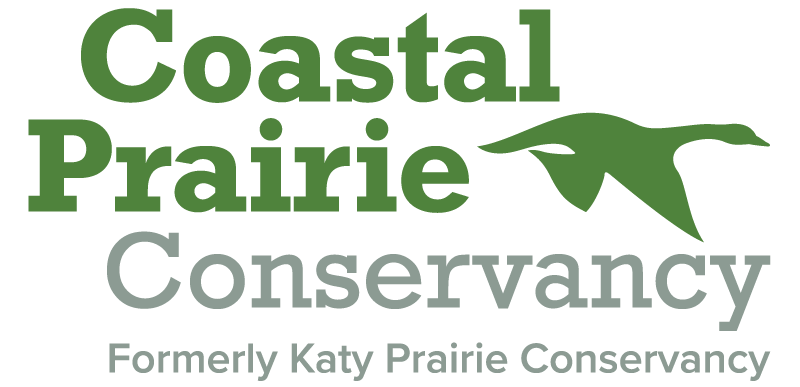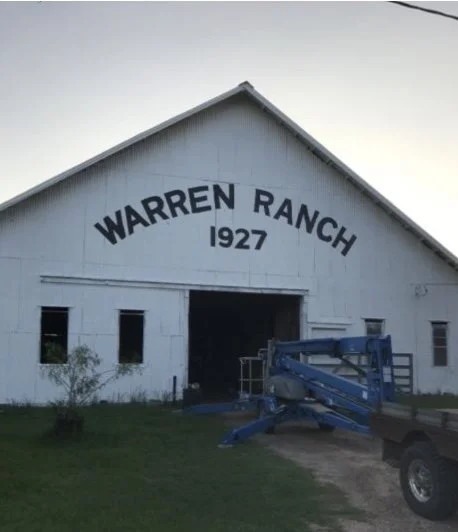A Spring Walk in the Warren Ranch Saline Barrens
by Wanda Anglin
Introduction
A group from the Coastal Prairie Conservancy and the Native Plant Society of Texas – Houston Chapter recently came together for a guided walk through the rare and rugged saline barrens of Warren Ranch.
It was one of those perfect spring mornings—crisp air, blue skies, and the promise of discovery. Before diving into the highlights of the walk and the incredible species we encountered, it’s worth taking a moment to explore what makes Warren Ranch, and its unique saline barrens, such a remarkable place.
About Warren Ranch
Photo by Wanda Anglin
The Coastal Prairie Conservancy owns over 13,000 acres in Waller and Harris Counties, including a majority interest in the 6,004-acre Warren Ranch, permanently protected in the summer of 2004. As neighboring ranches have succumbed to housing development, Warren Ranch thrives as a remnant of Texas’ shrinking farming and ranching heritage.
The ranch, located in far northwest Harris County is part of the historic Katy Prairie, is a prairie wetland ecosystem supporting 300 species of birds; 110 species of mammals, amphibians, and reptiles; and 600+ species of grasses, wildflowers, trees, vines, and shrubs. The expansive ranch has continuously operated since 1883 when it was founded by England-born immigrants, John and Jane Warren. It is one the last sizable working cattle ranches in Harris County located 3 miles south of Hockley.
Challenges in Conservation
Snapshot of migrating monarch butterflies.
The diverse landscape within the working cattle and farming ranch offers many exemplary opportunities to preserve prairie habitat and demonstrate practical conservation practices. Rather than replace native grasslands with one or two introduced grasses is common practice on Texas ranches, the ranch manages the native prairie and grassland habitat for profitable cattle production and wildlife habitat.
This ranching model has many benefits for people and wildlife, including supporting declining grassland bird populations. Warren Ranch is also a hot-spot for migratory and wetland birds. Other wildlife out on the prairie includes migrating butterflies such as the monarch, alligators, coyotes, beavers, deer, and bobcats. In 2012, the Katy Prairie Stream Mitigation Bank (KPSMB) project embarked on restoring 20 miles of streams and channelized waterways on the ranch, including 5+ miles of restored streams feeding into Cypress Creek. The prairie also benefits humans, with prairie grasses’ deep roots, riparian zones and their related wetlands slowing floodwaters into Houston.
Saline Barrens
Satellite image of the Warren Ranch saline barrens.
A saline barren is sometimes called a saline glade or slick as it is an interruption of the type of vegetation expected in prairie communities.
Barrens are sparsely populated with plants of a much lower height compared to surrounding tall grass prairies. On aerial imagery, barrens often appear bright white and devoid of vegetation. A satellite image of saline barrens located in the western portion of Warren Ranch where the tour occurred are provided as an example of this unique signature.
The saline barrens system occurs in portions of the Gulf Coastal Plain west of the Mississippi River on soils with high saline content. The barrens most commonly occur in Arkansas, western Louisiana, and the eastern third of Texas.
There is not a definitive answer as to the exact physicochemical processes that produce saline barrens. Few common characteristics are found in areas of the world where saline barrens form.
There are hypotheses about how saline barrens form. One of the most prevalent, and the one that our knowledgeable guide, Andy Newman, Chief Ecologist at The Earth Partners, and guide for the walk in the barrens, shared is paraphrased here: The impervious clay hardpan under the silty soil prevents drainage, forming an occluded high water table. Salts present in the overall geology are dissolved when it rains and settle into the middle elevations of the landscape due to hydrostatic pressures moving water and dissolved solutes laterally within the soil. Salt barrens experience intermittent extremely dry and extremely wet conditions, thus hyper accumulations form overtime. In this wet/dry cycling, salts accumulate into surface soil strata.
Within the Texas coastal plain, salt barrens are frequently found in the general vicinity of salt domes on the Beaumont and Lissie Geologic Formations.
Salt domes are largely the result of evaporative processes associated with Jurassic oceans in the ancestral Gulf of Mexico accumulating deep salt layers that eventually ooze upward, fracturing younger geologic stratums. Within this layer, often vast salt deposits can be found. They are the source of salt domes that form when the salt layer finds a crack in the rock layer above and pushes through. Often oil and gas drilling occurs around salt domes as the fractures created as the salt dome pushes upward collect petroleum deposits.
Did you know that just south of Hockley (northwest Harris County) that just 1100 feet below the surface, there is a great salt deposit? Since 1928, United Salt Company has been mining salt from that location for industrial uses (animal feed, water softener pellets, etc.). The mine is just south of Warren Ranch.
The saline barrens located in East Texas appear to be driven by different geologic processes. Due to the alternating sea levels and riverine depositional processes that formed the base geology of East Texas, higher sodium levels could also be associated with shallow marine or lagoonal depositional patterns. When higher sodium sedimentary layers are present, sodium molecules seem to be concentrated due to hydrostatic processes mediated by water movement between mima/pimple mounds and depressions resulting in a “pooling” of higher saline soil.
Due to the rarity of these barren habitat types, more detailed investigation could be helpful in understanding the processes that led to the formation and maintenance of saline barrens.
Saline Barrens as a Habitat
Sodium is very toxic to most vascular plants. As a result, only a few species of small flowering plants, lichens, algae, and cyanobacteria dominate saline barrens with a few grasses that often grow shorter than their counterparts in less saline soil.
Texas Prairie Dawn photographed on the tour. Photo courtesy of Wanda Anglin.
Because of the high saline soil and the intermittent wet/dry cycles, flora within the barrens must not only be adaptable to high salinity, but also must be xerohydric (adaptable to alternating wet and dry conditions). These unique conditions have resulted in uncommon adaptations to deal with the harsh extremes of the barrens.
Some species such as Texas prairie dawn have evolved specifically to live in these conditions, while some species within the barrens such as Texas saltbush (Atriplex texana) and woolly tidestromia (Tidestromia lanuginosa) can also be found on extensive salt flats associated with tidal environments on the coast.
A Spring Walk into the Saline Barrens
Jaime Gonzalez in action photographing Texas prairie dawn. Photo courtesy of Wanda Anglin.
In late March, just as spring wildflowers began brightening southeast Texas, CPC and Native Plant Society of Texas - Houston Chapter (NPSOT-HOU) organized a walk through the Warren Ranch’s prairie across the road from Warren Lake. Lan Shen, CPC Seed Collection Manager and Great Grow Out Coordinator, welcomed us and introduced our guide Andy Newman who had exceptional ecological and geological knowledge from a variety of professional positions held and the many organizations he has volunteered for. Doreen Gallevo, Director at Large, NPSOT-HOU, that sponsored and organized the event also welcomed the group of about 25 nature enthusiasts.
It had rained for several days (a welcome relief for a very dry early spring/late winter) so most wore rubber boots or waterproof hiking boots.
Photo courtesy of Wanda Anglin.
Andy led us on a short walk through what felt more like a pasture than prairie to a tall grass prairie that soon gave way to patches barren of tall grass. The saline barrens! Surprisingly, there is notable line of demarcation where a barren begins.
Texas Prairie Dawn
Prairie dawn flower. Photo courtesy of Jeff Hodges.
Texas Prairire Dawn is a rare species endemic to saline barrens only known to be in the Western Gulf Coastal Plain and South Central Plains (formerly Piney Woods) in Fort Bend, Gregg, Harris, Trinity and Waller counties. On the federal and Texas state endangered lists, the tiny flowering plant faces urban encroachment and agricultural appropriation.
Texas prairie dawn has delicate light pale yellow rosettes called ray florets. The flat-topped flower head is composed of a tight disc of 40-75+ very small, yellow flowers. Two rows of overlapping green, leaf-like structures closely cup the flower head. Flower heads have no obvious “petals” because they are hidden behind the leaf-like structures.
The floral stalks sprawl upward and outward. Its paddle-shaped leaves may be shallowly lobed, saw-toothed, or smooth-edged and mostly appear at the plant base and flatten to the soil.
I was surprised that we did not have to search for the rare flower. Once we encountered a saline barren, they were the dominant plant in much of the area. While they are rare on Earth, they are common on the Warren Ranch saline barrens.
Learn More
Watch these calendars for future events…and follow the related organizations on social media:
Get Involved!
Volunteer for or join NPSOT-Hou
Bio
Wanda Anglin is a lifelong student and admirer of the natural world and its interwoven systems. She is fortunate to live on a farm in a unique area of northeast Colorado County near Columbus, TX, where the coastal prairie meets the post oak savannah and Blackland prairie ecoregions as well as being home to the southeastern tail of the Lost Pines belt. All these ecotypes are seen on her small farm. As a Texas Master Naturalist, she participates in many citizen science projects that build on her understanding of how water, air, soil, flora and fauna, climate, and how humans choose to use Earth’s resources are all inter-related. A change in one results in changes in the other systems. She jumps at every chance to share opportunities to help others understand how they can promote the natural world they want while enjoying Earth’s bounty responsibly. Many thanks to our walk guide, Andy Newman, for helping with the more technical details of this article.
Sources
Native milkweeds. Xerces Society. (n.d.). https://xerces.org/milkweed
Wheeler, J. (2019a, April 19). Tropical milkweed-a no-grow. Xerces Society. https://www.xerces.org/blog/tropical-milkweed-a-no-grow
Recommended Reading
The Monarch Effect: Surviving Poison, Predators, and People by Dana L. Church
The Monarch Butterfly Migration: Its Rise and Fall by Monika Maeckle
Native Host Plants for Texas Butterflies by Jim Weber, Lynne M. Weber and Roland H. Wauer








